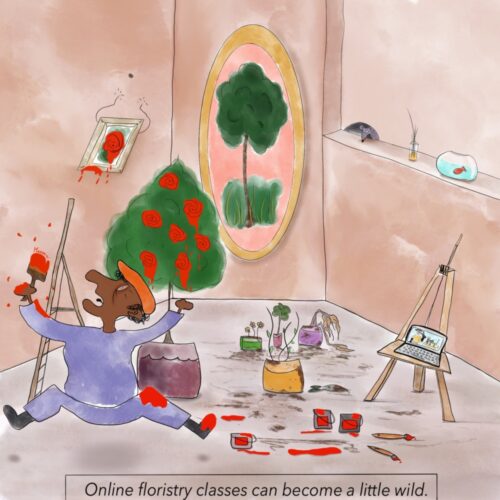Tending Florists and Horticulturists in Harsh Seasons
By JohnTaylor Wildfeuer
Planting and tending, trimming and arranging, it would be hard to imagine wanting a career working with nature without a love of working with one’s hands, but seeding the skills needed without time in the soil is a thorny endeavor.
In backyards, balconies, and window boxes across the Bay Area an increased interest in greening one’s thumb has brought color and a sense of consistency to budding home gardeners.
As a result, orchid specialist Tom Perlite is teaching his first course this semester to a class of students for whom, “This seems to be their first foray into horticulture.”
With restaurants and cafes cautiously reopening, the city may see a return to the often lavish and opulent bouquets local patrons had grown accustomed to before surviving the COVID-19 pandemic became all-consuming.
In light of this, the resurgent and ongoing need for florists and horticulturists seems inevitable, and so too the need for quality education on the subjects.
Within City College’s Environmental Horticulture and Floristry department there is no debate as to the importance of hands-on experience, of learning literally in the field, or in the greenhouse as the case may be.
Steven Brown, department chair, is determined to once again offer firsthand, tangible engagement, one of the first of many sacrifices to COVID-19 safety protocols.

“We are not really able to do a good job of training people to work in our industries without an in person learning experience,” Brown laments, noting that even when these offerings are once again permitted they “likely cannot be a part of consideration for one’s grade” due to the current inaccessibility of City College greenhouses to students.
Perlite adds, “the hands on experience is not there, which is a drag.”
This time of year students in the greenhouse production class would typically be rooted in a greenhouse designated for the annual crop of one thousand Poinsettias, planting and pinching over their ten-to-twelve week growing period.
Tom Perlite, who volunteered in the department for four years before becoming a City College instructor and has worked in the Orchid industry for ten times that length, mourns the loss of the tradition this fall.
Perlite explains, “If you’re growing them for production or sale, you basically plant the cuttings at the end of August, and then they are harvested or sold right after Thanksgiving. So it’s perfect for the fall class.”
Thomas Wang, a fellow instructor in the department, feels similarly, and, with collaboration from others in the department, has made a herculean effort to meet students not only halfway, but the entire way if necessary to ensure that they have what they need to prepare themselves for work in the field.
“Throughout the semester we have had plant giveaways, plant drop-offs, outdoor consults, and walkabout gardening sessions in public spaces,” Wang recalls
Perlite and Wang, resolved to help students approximate the full and varied experience the department has provided in the past, set up at the Botanical Gardens with plants for students, and even “delivered a number of the plants to a number of students that were unable to meet,” says Perlite.
This, naturally, serves the students and the expressed need for tactile practice, but it is also a sort of adoption program for some of the many plants left to be tended by the department’s skeleton crew.
Brown matter-of-factly states, “We have no one to assist with the maintenance of the department. Most faculty are working from home, no lab-aid, no volunteers, just me and our nursery specialist and we are trying to keep our hours to a minimum.”
City College’s nursery specialist, Sungmun Ryu, manages the college’s lath house and three greenhouses as well as just about every living thing in and around them save orchids, from scores of donated plants to crops in the outdoor growing space. “She’s remarkable,” Perlite notes, “she does a great job.”
These outdoor spaces and others could make for a safe space in which to learn and grow, “when the education system is okay with us teaching small cohorts of maybe 8 people at a time in an outdoor setting,” Wang proposes. “We have suggested this numerous times,” he continues, “but still no go.”
